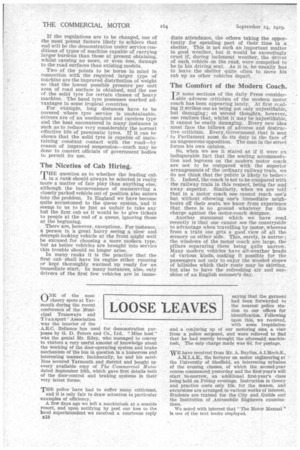Meeting Transport Conditions in Overseas Countries.
Page 43

Page 44

If you've noticed an error in this article please click here to report it so we can fix it.
TT is becoming increasingly obvious to the British commercial-motor manufacturer that in future years a considerable proportion of his annual production must be marketed abroad. Naturally, when embarking upon the construction of models for export _purposes, the first consideration is the existing and possible future 'trend of local legislation in the countries to which the vehicles will be sent.
An almost universal problem in the lessdeveloped lands is that of regulating axle loads so as to prohibit the use of machines imposing unfair burdens upon the highways. These are necessarily constructed upon more primitive lines than those which obtain in countries having an economic system built up . during many centurieS of concentrated development.
It is quite common abroad to find that load 'capacities are restricted to two or three tons and that solid tyres are not permitted. These limitations naturally confine road transport to a position far, less important than it is justified to maintain besides increasing its cost. It mist be remembered that the cost per ton-mile decreases in proportion to the increase in load capacity of the vehicle.
A particular instance brought to our notice by a transport expert in Java concerns a 30 * ton load which had to be transported over a certain distance. When a 3-ton vehicle, doing ten trips, was employed, the cost was 15 per cent, higher than if a 5-ton wagon had been used. With a 2-ton machine, doing 15 trips, the cost was 30 per cent. more, whilst it increased by 42 per cent. in the case of a onetonner.
Obviously the load restrictions imposed are reasonable in many cases in view of the existing natural and financial circumstances which cannot easily be altered. The vehicle manufacturer must, therefore, bear in mind that whatever vehicles he proposes to employ in the near future there is every possibility that the existing axle-load regulations overseas will be maintained for some time to come. Therefore it would appear necessary to concentrate at first upon machines capable of immediate use under existing regulations, but at the same time the need for a larger unit must not be overlooked.
If the regulations are to be changed, one of the most potent factors likely to achieve that end will be the demonstration under service conditions of types of machine capable of carrying larger burdens than those at present obtaining, whilst causing no more, or even less, damage to the road surfaces than existing models.
Two of the points to be borne in mind in connection with the required larger type of machine are the improved distribution of weight so that the lowest possible pressure per unit area of road surface is obtained, and the use of the solid tyre for certain classes of heavy machine. The band tyre possesses marked advantages in some tropical countries.
For example, long distances have to be covered where tyre service is unobtainable, drivers are of an uneducated and careless type and the heat encountered in many instances is such as to reduce very considerably. the normal effective life of pneumatic tyres. If it can he shown that the solid tyre is capable of maintaining constant contact with the road—by reason of improved suspension—much may be done to convert officials of government bodies to permit its use.




















































































































